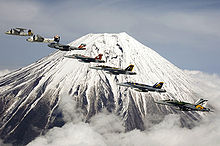CAG Bird

With CAG bird , a plane is called, which in a carrier squadron (Carrier Air Wing) of the US Navy formally the commanding officer ( Commander Air Group , CAG) is assigned. Most of the time, this aircraft, which is highlighted by unusually colored markings, is not flown by the CAG.
Each squadron of a carrier squadron names a CAG bird, so that there are six different CAG birds on a carrier within an air wing. In addition to the striking color scheme, these aircraft can be recognized by the fact that the serial number on the bow within a squadron (also called Modex) always ends with "00".
history

While until the mid-1920s the aircraft of commanding officers were only made recognizable by affixing an "official seal" or badge of rank, it became customary until 1934 to keep the fuselage of such aircraft in a dark blue. Occasionally, an admiral's stand (white stars on a blue field) was attached to the strut between the wings.
On May 5, 1934, a service instruction stipulated the painting of “special aircraft”. This describes the color scheme for the machines of "flag officers" and for those of commanding officers (including on aircraft carriers). According to this, for the latter, the front fuselage of their aircraft should be kept in admiral blue up to the rear end of the wing root, for other areas aluminum-silver, gold and chrome were prescribed. The aircraft of the CAG should also lead a diagonal strip from the engine to the wing transition and the lettering Air Group Commander under the cockpit. The specified color of the Air Group was prescribed for the stripe.
In November 1946, aircraft identification was introduced in the US Navy, which largely corresponded to the three-digit Modex number system that is valid today. The Air Group Commander received a full hundred number as identification. On August 4, 1948, at the same time as the system was expanded from four to nine squadrons, it was determined that the CAG should receive the bow number “00”, which is only assigned once within the Air Group, or another number below 100. In addition to the “00”, an F4U Corsair with the identifier “01” and an F8F Bearcat with the marking “0” are also known. Full hundreds (100, 200, ...) were not awarded. It was not until March 1955 that the system, which was valid from 1946 to 1948, was reintroduced, whereby the only CAG Bird of an air group receives a number from this range of numbers.
It was probably also introduced in 1955 that not only one CAG Bird may exist in the Air Group, but that each Squadron can provide its own CAG Bird. From 1955 to the beginning of the 1960s it was also common for an aircraft of the squadron in which the Air Group Commander originally served to carry the identifier "00" (Double Nuts).
literature
- Duane Kasulka: USN Aircraft Carrier Air Units Volume 1 , Squadron / Signal Publications, 1985, ISBN 0-89747-164-4 .
- Duane Kasulka: USN Aircraft Carrier Air Units Volume 2 , Squadron / Signal Publications, 1985, ISBN 0-89747-172-5 .
- Duane Kasulka: USN Aircraft Carrier Air Units Volume 3 , Squadron / Signal Publications, 1988, ISBN 0-89747-218-7 .
- Thomas Doll, Berkley Jackson, William Riley: Navy Air Colors Volume 1 , Squadron / Signal Publications, 1983, ISBN 0-89747-143-1 .
Web links
- Explanations with examples for CAG Birds (accessed December 17, 2015)